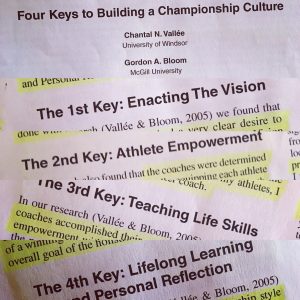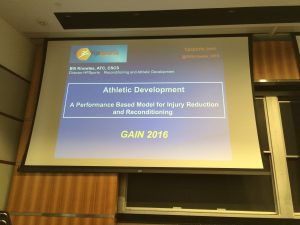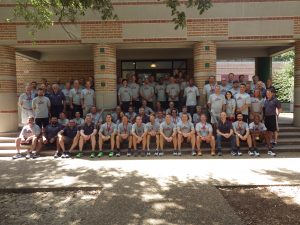Recap GAIN IX…
Having just returned home from another awe inspiring GAIN experience, my 2nd GAIN in a row now, I thought I would share with you some of the key parts of this experience and some of the key messages shared throughout the week…
GAIN Mission
“Provide a global platform for education, innovation and motivation in Athletic Development. The focus is on developing and strengthening the connection between all elements of the sports performance team to produce adaptable athletes that are prepared for optimum performance.”
GAIN Goals
- “Provide a career defining educational experience for all involved;
- Define the field of Athletic Development;
- Reinforce the concepts that: Training = Testing and Testing = Training/Training = Rehab and Rehab = Training.”
GAIN X Theme
“The Coaching Process – Leading Effect Change”
The Three Prongs of GAIN…
- Coaching;
- Sports Medicine;
- Physical Education.
One Mission – One Team
“We are more likely to overcome our struggles and difficulties to find what we are looking for when we are willing to take others with us on the journey.” (Simon Sinek)
One Purpose
“To instill a culture of daily physical preparation that grows & nurtures adaptable athletes who understand the wisdom of their bodies, its ability to self organise & solve movement problems.” (Vern Gambetta)
6:30am Teaching Sessions
These are another fundamental factor that underpins what GAIN is all about… It gives you the opportunity to learn practically from the WORLD CLASS GAIN Faculty and apply the theory and examples they give in their presentations.
Each morning there are 3 stations that each group moves around spending about 15/20 minutes at each station… so over the course of GAIN we get to experience 11 or 12 different aspects of Athletic Development. All these sessions are carried out on the Rice University Athletics Track before breakfast.
Wade Gilbert: “Building a Culture of Competitive Excellence”
“Our culture helped us win the game”
Here are a few key messages that Wade gave during the introduction…
- Transform moment of excellence into CULTURES of excellence;
- The coach defines and shapes Team Culture;
- Team Culture dictates athlete behaviour;
- Change the environment to change behaviour.
He then went on to share in detail each area of a ‘Culture of Excellence’…
- Core Values;
- Personal Mastery;
- Authentic Learning (Reflection);
- Complex Family Environment.
Wade next shared the research article that looked into the inner workings of the New Zealand All Blacks rugby team…
The last part of his first presentation shared the Self-Determination Theory and the 3 human basic needs of… Autonomy, Relatedness and Competency.
Wade Gilbert: “Reflect and Grow”
During Wade’s 2nd presentation he went into depth of the square ‘Authentic Learning (Reflection)’ from the ‘Culture of Excellence’ quadrant…
“Experience is a great thing – everyone can learn from it.”
“Those coaches content with the past make good door mats for those coaches knocking on the door of opportunity.”
One of the best things that Wade does is bring research to life…
The key points being…
- Obsessively passionate about coaching and excellence;
- Thirst for knowledge, continuous learning.
“Focus on the Process not the Outcome”
He then shared the Reflection Framework…
- Reflective Practice: How to resolve a coaching issue, Solve problems = Single Loop Learning;
- Critical Reflection: Thinking about why I think it is an issue = Double Loop Learning.
He also shared one the core parts of the Toyota process that makes them so successful as a business…
- Plan;
- Do;
- Check;
- Act.
Ken Clark: SPEED and CHANGE OF DIRECTION
First up I was blown away by the passion and enthusiasm Ken had as a presenter, let alone the amount of expertise and knowledge he had.
Speed Science: The Mechanics underlying Linear Sprinting Performance
Speed is the most important physical quality/characteristic. If you’ve speed you’ve got a spot somewhere on a team. One of the key things with Ken’s and Dr Peter Weyand’s research on sprinting, is that they have looked across the ‘Spectrum of Ability’: Developmental, Intermediate, Professional and Olympic and they know what separates the fast from the fastest.
The key BIG takeaway from this presentation from a Mechanical Goal is to apply more force (relative to body weight) and to apply that force faster (maximum rate of force application) in an optimal direction.
The key BIG takeaway from this presentation from a Technical Goal is a neutral stable posture (Get long and strong/braced), have a powerful frontside recovery (Punch, Push, Switch-off), and stiff ground contact under Hips (“Hammer the nails”).
“What separates FAST v. SLOW runners…?”:-
- Faster Speed = Shorter contact time;
- Faster Speed = Greater vertical force.
Speed Science: Mechanics underlying Multi-Directional Performance
“Multi-Directional Speed determines if you can use your Linear Speed”
Ken shared the difference between ‘Change of Direction’ and ‘Agility’ with the key difference being the Cognitive/Decision Making aspect to ‘Agility’.
Pattern recognition and Postural cues are the key differences at the top level in the sense that the higher the level, the faster that these players recognise these cues, and thus have more time to apply their speed in the right direction.
Some of the key things…
- The lower the Centre of Mass the better…;
- Eccentric and Isometric Strength are very important;
- The shallower the cut, the more important pure Linear Speed is.
Bill Knowles: Athletic Development and Reconditioning
One of Bill’s roles is the Director of Athletic Development for the Philadelphia Soccer Union in the USA… In 2 and a half years he’s had no Hamstring strains and only 1 ACL injury. Then if I was to tell you that several hundred players are part of the Academy and train/play like 6 times a week. That’s nearly 100,000 occasions when players are on the field a year. So in nearly a quarter of a millions points he’s had 1 ACL injury and NO Hamstring strains.
At the Soccer Academy they have 1 system from the 14 year olds through to the 1st XI that play in the MLS Soccer League.
ATHLETIC DEVELOPMENT: A Performance Based Model for Injury Reduction and Reconditioning
One of the foundations of this model is developing a better soccer playing athlete. The 5 stages to this process are…
- Build Physical Sustainability;
- Coach the Athlete to Physical Competence;
- The Journey through Physical, Technical and Tactical Development;
- Whose responsibility is it…?;
- The Cumulative Process.
Some of the key messages were…
“Keep Physical Competence one step ahead of Technical and Tactical”
“Multi-sport athlete to 14/15 years old”
“Investment everyday… Build up over time…”
The 4 pillars of Athletic Development Training…
- Gymnastics;
- Multi-Dimensional Speed and Agility;
- Strength;
- Competitive Co-ordination Games.
RECONDITIONING: A Performance Based Model for Injured Athlete
The key messages Bill shared in this presentation were…
- It’s a balancing act between Protecting v. Preparing the injured athlete;
- Rehab is a Medical based model v. Reconditioning is a Performance based model;
- A Rehab model focuses on what the athlete CAN NOT do;
- A Reconditioning model focuses on what the athlete CAN DO;
- A Rehab model has the injury at the centre and a large part of the jigsaw puzzle;
- A Reconditioning model has the athlete at the centre and the main focus the jigsaw puzzle.
Vern Gambetta: WINNING THE WORKOUT
I share a few of the points Vern shared with us…
- Training session needs to be close to your event in some form;
- Seek Perfect Effort;
- 3 Rs: Routine, Repetition, Refinement;
- Beware the 3 Ls: Laps, Lines and Lectures;
- Injury Prevention is a transparent part of each session;
- Coach Driven and Directed, Athlete Centred, Everyone involved and engaged…;
- Training = Testing and Testing = Training;
- “Sometimes what you can’t see is more important than what you can see..”.
Meal Times
Probably the most underrated part of any Seminar/Clinic/Workshop/Conference is the time given between lectures/presentations/practicals to reflect, network and take time out to get to know people personally.
At GAIN, Vern does a great job with the schedule to ensure there is ample time between the different sessions. It is by design that this happens. One of the many outcomes of entering the GAIN Professional Network are the connections you make. These meal times make those connections much more personal which adds another layer to the overall whole experience. You delve right past the superficial things and really get to know people on a personal level. So many personal friendships start at the dinner tables.
The quality and quantity of food puts the icing on the cake! It is all you can eat, a help yourself service and there are so many options to have at each meal time. At breakfast you’ve got your fruit and cereals, a cooked breakfast option and/or toast and bagels. There are always 3 options for hot food at lunch and dinner times or you can always opt for the salad bar. There is a variety of unlimited drinks at each meal time.
The Faculty
What can I say…?! Simply world class!
This is one of the best things about GAIN… the QUALITY of the Faculty members who give up their time amongst their very busy schedules to share their vast knowledge and experiences. They are at the top of their games at the highest levels of competition across a whole range of levels and competitions.
For example, you have:-
- Wade Gilbert along the Coaching prong…
- Randy Ballard along the Sports Medicine prong….
- And Greg Thompson who’s along the Physical Education prong…
The People…
I will say it again… What makes GAIN…?! The People!
The people who invest in themselves to strive to become the best that they can be for the benefit of the athletes and players they coach. GAIN is not a one off clinic, seminar or meeting. It is an investment in yourself to get bette at getting better. It is an experience where lifelong connections and friendships will be made… We are all part of an amazing profession and what separates the best from the rest is their continued quest for lifelong learning and improvement. We challenge each other and others… We ask questions…We challenge the norm… We create our own paths… We seek help when we need it… We seek advice when we are in a corner… We are there to support and encourage each other…
The people are so humble and approachable… You can spark up conversations with anyone at anytime… whether it be at 6:20am walking towards the track for our teaching sessions… at any of the mealtimes in the Dining Hall… on the way to and/or back from one of the presentations in the Lecture room… or sat outside the watering hole in the warm evenings…
Closing thoughts…
Vern encourages you to… Engage, Participate, Share, Learn, Respect and Enjoy. I certainly will echo these words and I have learnt so much since going to GAIN VIII, interacting on the GAIN Forum and connecting with numerous GAIN members over Skype or FaceTime #Anywhere #Anytime.
And going back to the GAIN goal of “Provide a career defining educational experience for all involved”, it most certainly does! With this being my 2nd occasion going to GAIN now, I wouldn’t miss it for the world. Each one has been very different and very similar at the same time.
“What made it very different…?” The continued variety of WORLD CLASS presenters and different topics that are presented each year.
“What made it very similar…?” The overwhelming feeling you have on the taxi ride back to Houston International Airport where GAIN has blown you away again and surpassed the expectations you had by several light years.
All I can do is urge you to make an application to GAIN sharing your Philosophy with Vern and hopefully I’ll see you at the next GAIN…






















